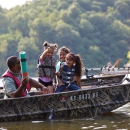
Lampreys are obligate ectotherms and directly influenced by the ambient water temperature. In a variety of species other than Pacific Lamprey, evidence exists that lethal water temperatures for larvae occur near 27.0-31.0°C (e.g. Potter and Beamish 1975; Arakawa et al. 2020). Relatively few studies have addressed the thermal tolerance of larval Pacific Lamprey. Recently, Uh and Whitesel (unpublished data) conducted laboratory experiments in which larval Pacific Lamprey were able to survive in 27.0°C water for 30 days and suggesting the ultimate upper incipient lethal temperature (UUILT) for larval Pacific Lamprey is approximately 27.5-30.0°C. How climate change climate change
Climate change includes both global warming driven by human-induced emissions of greenhouse gases and the resulting large-scale shifts in weather patterns. Though there have been previous periods of climatic change, since the mid-20th century humans have had an unprecedented impact on Earth's climate system and caused change on a global scale.
Learn more about climate change will influence the status of Pacific Lamprey is uncertain (see Wang et al. 2020). Currently, many of the locations where Pacific Lamprey rear naturally experience water temperatures near 26.0°C. With predictions that during the next 25-35 years in the Pacific Northwest air temperatures may rise 2-5°C (Wu et al. 2012), maximum water temperatures where some lamprey exist now may exceed the lethal limit for larval Pacific Lamprey. Whether the UUILT derived from larval Pacific Lamprey reared in a laboratory reflects their natural distribution (i.e. in a stream), or whether there are sublethal effects at temperatures approaching their UUILT, is unclear. We propose to evaluate i) whether larval Pacific Lamprey occupy streams where water temperatures exceed 27.5°C, ii) whether larvae occupy areas that exceed 27.5°C at a similar rate than areas where temperatures do not exceed 27.5 and ii) whether warm conditions that are not lethal influence these larvae.



